Spiny McSpleen's Nifty

WEBPAGE
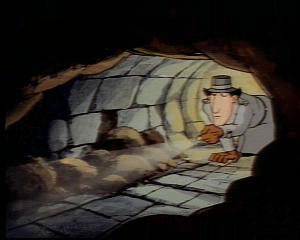
ABOUT THE SERIES
In 1981, the pilot episode for a cartoon entitled Inspector Gadget was written by Andy Heyward. This episode, called "Winter Olympics", featured a police inspector called Gadget -- so named because he somehow came to have 14,000 mechanical gadgets installed into his anatomy. After sketching 350 potential Inspector Gadgets, Heyward finally came to design the final appearance, albeit with one slight difference: a large, bushy moustache. After the first episode aired, DiC Entertainment, the firm with which Heyward was working to create Inspector Gadget, received a letter of complaint from film company, Metro-Goldwyn-Mayer, saying that Gadget too heavily resembled a character from one of their recent films and that something should be done to correct the similarity. Rather than design another character, DiC decided to simply remove Gadget's moustache. In the second episode and for the rest of the series, Gadget is clean-shaven.
The show was also used as a launching pad for the careers of several actors. For Cree Summer Francks (Penny) in particular, Inspector Gadget was the first acting job on her resumé. Don Adams (Gadget), however, had previously played the role of Maxwell Smart on the television comedy series, Get Smart -- and before that, he was the voice of Tennessee Tuxedo for the cartoon show, Underdog.
The show ran for two series during the years of 1983 and 1986. The first series was actually longer than the second, containing 65 episodes (series two had only 21). There was a two-year hiatus between the two series -- this was due mostly to several of the original cast choosing not to renew their contracts and the subsequent search for new voice actors. Near the end of the series, Don Adams left to pursue other opportunities, so Maurice LaMarche (who had replaced Chris Wiggins as the voice of Chief Quimby) was contracted to also play the voice of Inspector Gadget.
More than 20 years after its cancellation, Inspector Gadget still draws a cult-following. In 1999, Disney Pictures released a live-action, cinematic adaptation of the show, where Matthew Broderick played the role of Gadget. In 2001, a spinoff show entitled, Gadget and the Gadgetinis, began. It lasted one series and 52 episodes before being cancelled in 2003. Also, in 2003, Disney released a direct-to-video sequel to their 1999 film, this time with French Stewart playing Gadget.
CHARACTERS
INSPECTOR GADGET
A police detective with the Metro City Police Department. Gadget is so named because he has many mechanical gadgets installed in his anatomy. It is not known when or why he got his gadgets, however it was established in the series that one Prof. von Slickstein invented the gadgets and the means by which they operate.
Apart from having a dazzling array of gadgets, the Inspector is otherwise completely inept at his job as a crimefighter. Though he knows who his enemy is, he does not recognise them. Instead, he often mistakes enemy agents for allies, and vice-versa.
PENNY
Gadget's niece. Penny is usually the brains behind any operation. Though Gadget is given the assignment to catch a dangerous criminal, often it is actually Penny who solves the case and notifies the authorities on Gadget's behalf.
She makes use of a "computer book" (a device, the approximate size and shape of a telephone directory) and a wristwatch computer to do everything from blasting down brick walls to cracking into anything electronic. It is usually from the usage of these devices that Penny is able to stop a M.A.D. scheme.
BRAIN
Penny's dog. Brain will often disguise himself, in order to follow Gadget to places where Penny cannot go. More often than not, Gadget will mistake Brain for a M.A.D. agent and will try to catch and arrest him, ignoring the real agents. It is possible that, whilst on a case, Gadget forgets who Brain is, since a great number of the disguises he wears are very thinly veilled.
Brain's collar is actually a communication device, allowing him to remain in contact with Penny. Three of its studs will extend out; becoming a camera, a speaker, and a microphone.
DR CLAW
The head of the crime syndicate known as M.A.D. He is the typical villain archetype -- a shadowy figure whose face is never seen, sitting in a high-backed chair at a desk, with a computer to monitor anyone's every move.
It is not known why he and Gadget are nemeses, but he always plots ways to remove Gadget from existence. As with all "crimefighter-versus-villain" cartoon formulas of the age, Claw's attempts to eliminate Gadget are always thwarted, usually by Penny (though, Claw, himself, always assumes it is Gadget who foils his plans).
M.A.D. AGENTS
Dr Claw's subordinates. There is a great number of M.A.D. agents, each one trained in crime and self-preservation at the M.A.D. academy. Unless they are disguised, M.A.D. agents will always wear purple or black M.A.D. uniforms, with "MAD" across the front. Any vehicle they drive always conspicuously bears either the M.A.D. company name or the M.A.D. logo. Inspector Gadget never recognises any of the M.A.D. indicia.
MUSIC
The show's music was composed by Haim Saban and Shuki Levy, and distributed by Saban Records, Ltd. The Inspector Gadget theme is, arguably, one of the most well-known songs in television history. Its familiar chorus was actually based on Edward Elgar's In the Hall of the Mountain King from his orchestration of the folk-tale, Peer Gynt.
Several variations on the main theme are used for different instances throughout the series -- sometimes to convey emotions, other times to represent the location of the characters.
Each character has his or her own particular theme song, which plays whenever the character in question becomes a part of something important.
TRIVIAL INFORMATION
Inspector Gadget, himself, bears a resemblance to the anime character, Lupin III.
Penny has gained more of a cult following than Gadget. In fact, a picture of Penny drawn in the Japanese manga style is the most sought-after image within the character's fan-base. At one point, a web-ring existed that dealt in quasi-pornographic Penny fan-art.
One episode of Inspector Gadget needed to travel to several different countries before airing. Canada, for writing; France, for storyboarding; back to Canada, for voice recording; Japan, for animating; and Canada again, for post-production editing.
The film version's musical score (composed by John Debney) is derived mostly from the series' song "Welcome to the Kingdom" (militaristic with mostly snare drums and synthesisers), particularly the dramatic action songs.
An LP of some of the series' music was released in France between 1983 and 1984. Very few copies are known to have survived in playable condition. Because of its rarity, it is the single most sought-after item among Gadget collectors.
The LP, itself, contains only a relative few songs from the series, as there are, actually, several hours'-worth of source music.
In 1992, a Gadget videogame for the Super Nintendo Entertainment System was released. In 1999 and 2001, Gadget games were released for the Game Boy Colour and Game Boy Advance systems, respectively. There are also two Gadget-related titles available for the Sony PlayStation.
"Inspector Gadget" has been incorporated into modern vernacular, with the meaning of a person, particularly a law-enforcement officer, who makes regular use of many electronic devices.
As with many fictional criminal organisations of the day, the name, "M.A.D.", was not intended to be anything more than initials. However, collectors of Gadget merchandise will notice that it has been said to mean either "Mean And Dirty" or "Malevolent Agency of Destruction".
Inspector Gadget never removed his hat throughout the entire series. On one occasion, Gadget was moving so quickly that it appeared as though his hat had flown off -- though, if viewed frame-by-frame, it was revealed that Gadget was wearing another hat underneath the one that had fallen off.
PICTURE GALLERY

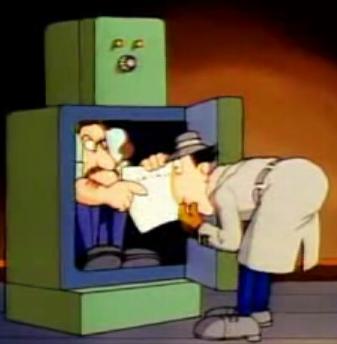
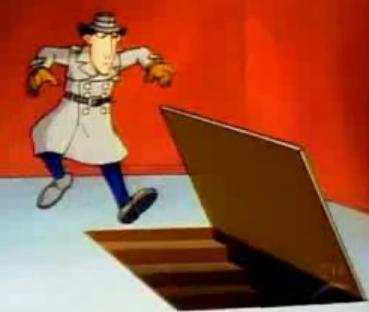
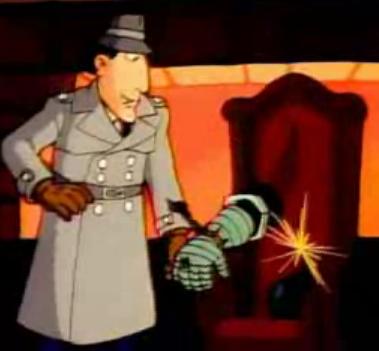

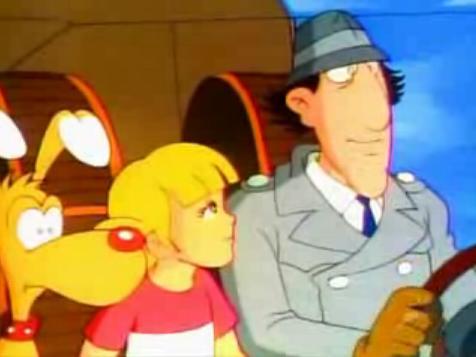
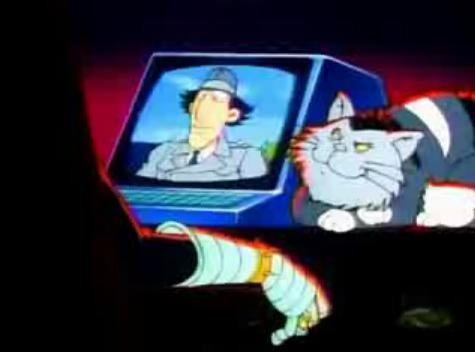
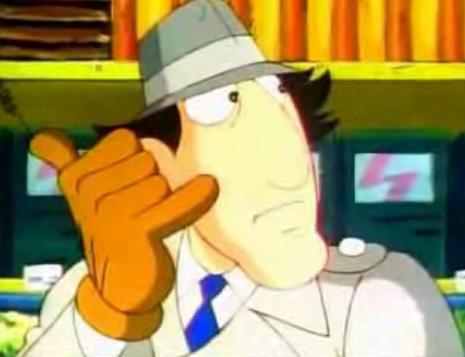
RELATED LINKS
Wikipedia Article on "Inspector Gadget"
HOME
Inspector Gadget and all related indicia, Copyright © 1982 DiC Entertainment, Ltd.
Page coding and layout by J. Sebastian Perry (a.k.a. Spiny McSpleen)













